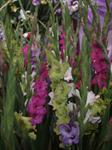Here are some tips on growing three common bulbs...
 1. Growing Daffodils
1. Growing Daffodils
Daffodils are one of the hardiest spring flowering bulbs. They will do well in most climates, with the exception of tropical areas. Soil should be well drained and fertile (enrich soil before planting with organic matter), with the planting site in full sun or part shade.
Daffodils can be used to create a number of different landscaping effects: plant in single varieties in massed beds for a formal appearance; intersperse with other plants in the garden bed in clumps or drifts for an informal effect, or plant under deciduous trees in random groups to create a naturalised 'wild' garden effect.
Planting should be done in early autumn. Plant bulbs at 10 15 cm depth and 10 25 cm apart (depending on the effect you wish to create). Flowering time varies according to variety the earliest varieties appear in early to mid-winter, whilst the latest varieties flower in late mid spring. After flowering, leave the leaves to die naturally as these will provide the food store for the next year's flowers. Increase bulbs by lifting and dividing every 3 4 years. The new bulbs will separate quite easily from the larger mother bulb.
Daffodils need cool conditions with daily maximums not over 21°C and preferably not over 18 however higher temperatures may be tolerated at the end of the growth cycle. Good drainage is also required.
2. Growing Gladioli

Gladioli grow from a corm. Leaves and roots emerge from the corm in late winter or spring and develop into a plant. The old corm is totally absorbed by the growth, but a new corm forms with many smaller cormlets forming around the base of the corm. At the end of the growing season, the leaves and roots die back, leaving only the corm and cormlets alive. The corm and cormlets will not re-grow until they have undergone a period of dormancy. Over this period, they are susceptible to rotting and hence need to be stored dry. Either remove dormant corms from a hydroponic system or leave the system dry for a period before attempting to start growing a new crop.
- Corms formed when the root zone temperatures are above 15°C are more dormant than those that mature when temperatures are cooler. Dormancy has been broken by storage at 5°C for 2 months followed by storage at 20°C.
- Adequate light is needed to produce flowers. If light intensity is too low or day lengths too short, flowers will not occur.
- Aeration is not as critical as with some plants, though good drainage is essential particularly for early or late flowers.
- High humidity around the developing spike can cause fungal diseases and damaged flowers.
- Drier conditions can increase the likelihood of foliage insect problems. Drier conditions cause earlier flowering.
3. Growing Liliums 
- Good drainage is essential. Heavy soils will grow Liliums, but only where they are well drained. Sandy soils built up with lots of compost may be better if you have the choice.
- A high organic content in the soil is preferred.
- Requirements can vary from one species to the next, so don't over generalize on growing requirements.
- All types should be protected from strong winds and excessive heat or cold.
- Weed control is important.
- Bulbs are lifted after flowering in mid to late autumn and stored under cool conditions before replanting in spring.
Read more about Bulbs with our ebook-Growing and Knowing Flowering Bulbs.
Love flowering bulbs? Study a course with ACS Distance Education on Cut Flower Bulbs.